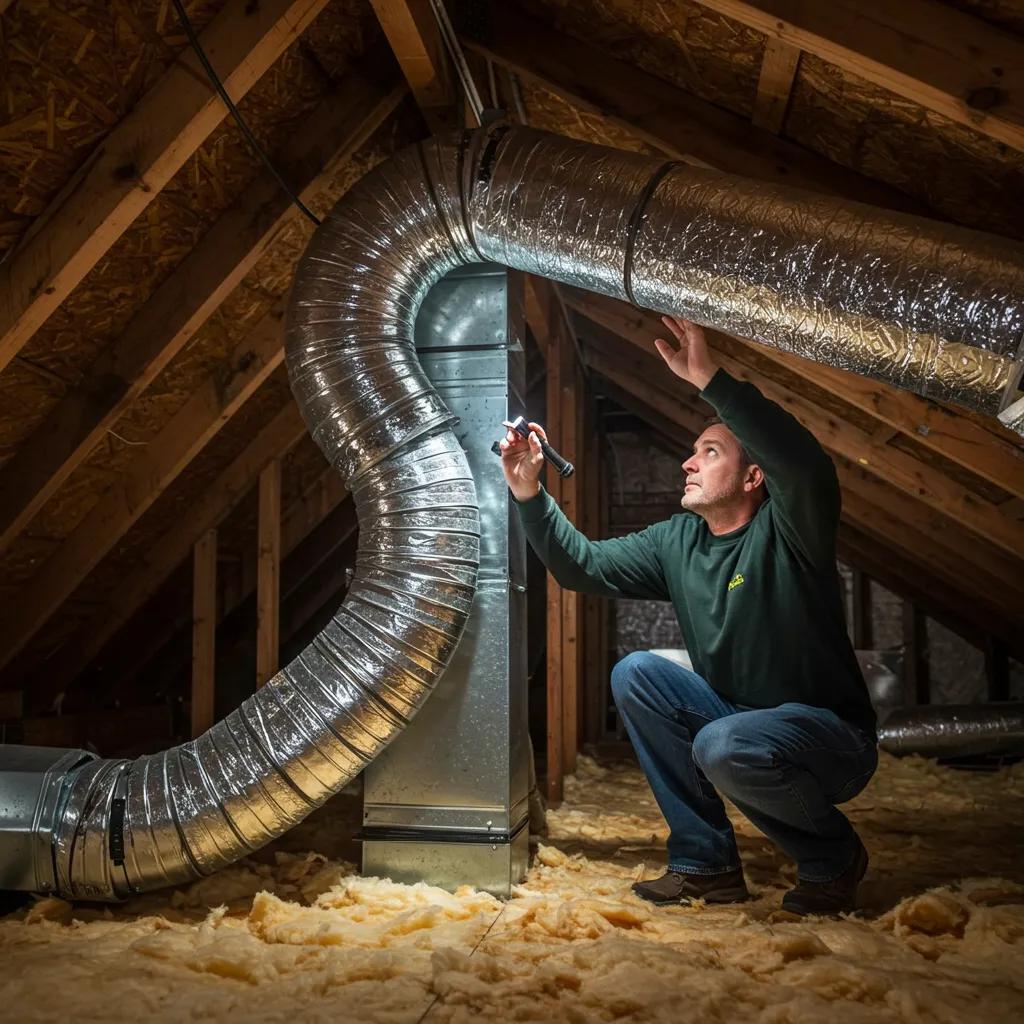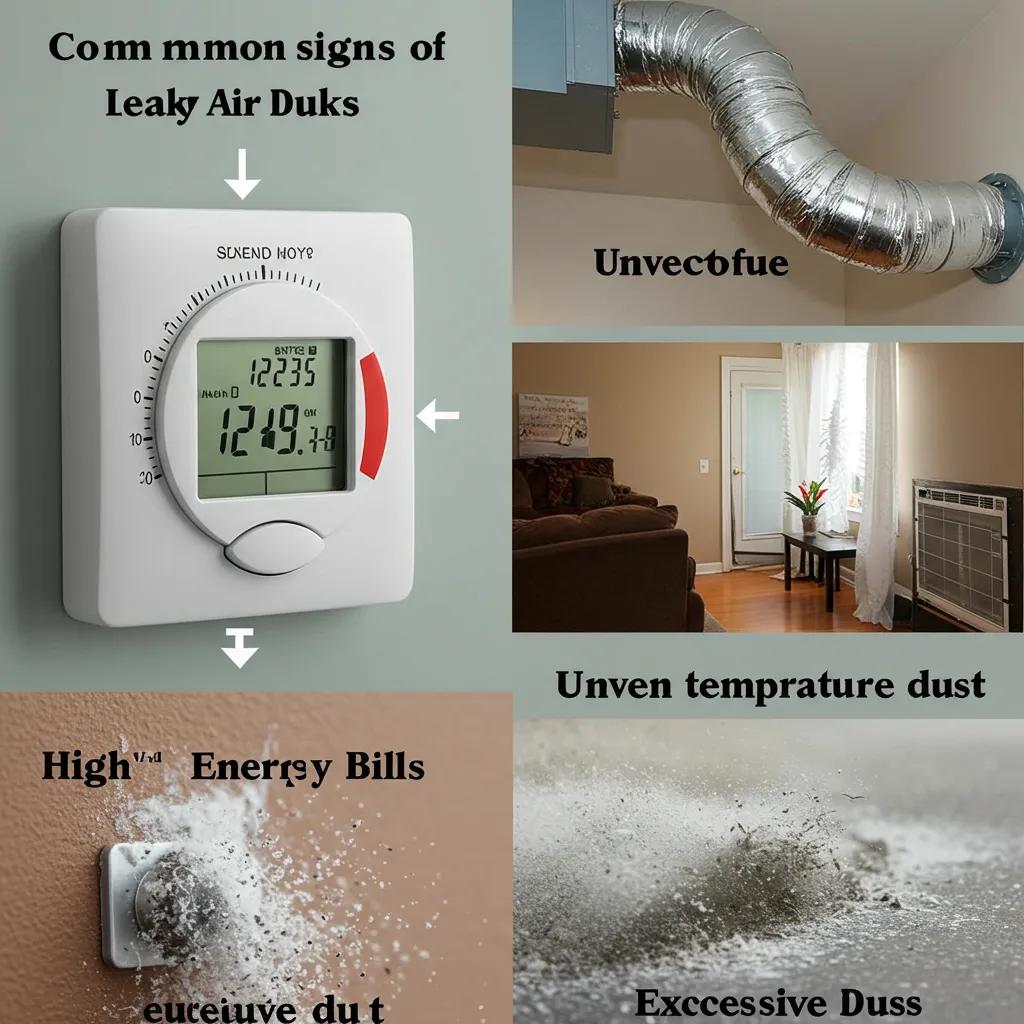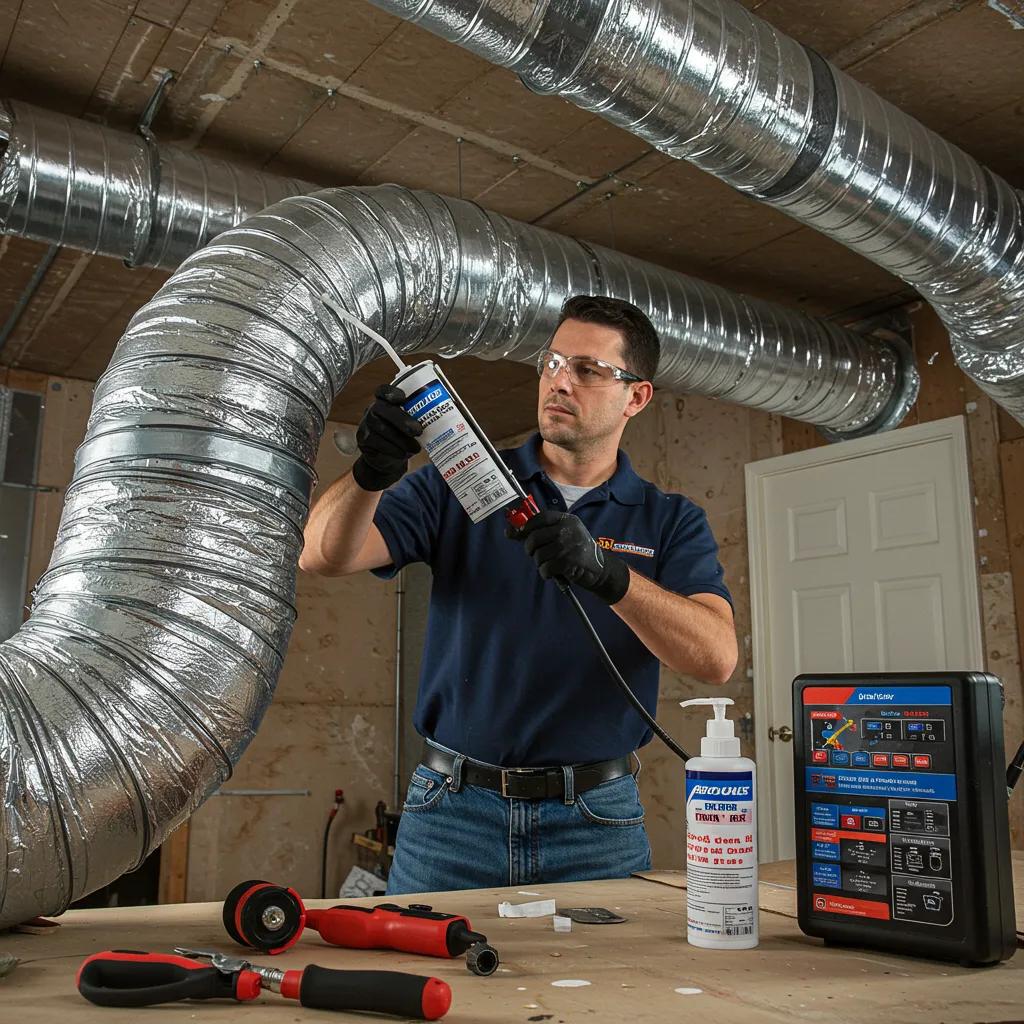
How to Inspect Ductwork for Air Leaks in Northwest Indiana Homes
Air ducts that leak up to 25 percent of heated or cooled air can drive up energy bills, compromise indoor air quality, and reduce system lifespan.
Energy Savings from Duct Sealing
Research from the U.S. Department of Energy and Energy Star indicates that leakyductwork can reduce HVAC system efficiency by as much as 20%, leading to increased energy consumption. Improving air sealing throughout a home, including duct sealing, can result in whole-house energy savings of 10% to 20% annually.
U.S. Department of Energy, Energy Star
This research directly supports the article’s claim that leaky ducts drive up energy bills and that sealing them improves energy efficiency.
In this guide, you’ll learn how to spot the most common signs of air ductleaks, perform DIY inspection tests, understand professional leakage testing methods, evaluate sealing benefits, uncover root causes, and estimate local costs. You’ll finish with clear steps to request a free estimate from Furnace Exchange LLC, your Northwest Indiana HVAC experts.
What Are the Common Signs of Leaky Air Ducts?

Leaky air ducts manifest through distinct symptoms that signal conditioned air loss and wasted energy. Recognizing these indicators early can prevent comfort issues and rising utility bills.
- High Energy Bills
Leaky ducts force your heating and cooling system to run longer, increasing monthly expenses. - Uneven Temperatures and Hot/Cold Spots
Gaps or holes in ductwork cause some rooms to overheat while others remain chilly. - Excessive Dust and Allergens
Cracks draw in contaminated attic or crawl-space air, leading to more dust and allergy triggers indoors. - Whistling Noises and Visible Gaps
Audible air jets at seams or register grilles often reveal small leaks that grow over time.
Spotting these warning signs sets the stage for a hands-on ductinspection, which we cover next.
How Do High Energy Bills Indicate Air Duct Leaks?
Elevated energy costs directly reflect lost conditioned air. When ducts leak:
- Your furnace or air conditioner cycles more frequently to maintain set temperatures.
- Longer runtimes consume extra electricity or fuel.
- Higher thermostat settings compensate for heat loss.
Noting a sudden spike in bills—especially compared with previous seasons—strongly suggests leakage that demands inspection.
What Are the Effects of Uneven Temperatures and Hot/Cold Spots?
Temperature imbalances result from air escaping before reaching registers. Key effects include:
- Rooms near the blower stay closer to set point.
- Distant or upstairs spaces feel inconsistent.
- Occupants adapt thermostats frequently, worsening energy use.
Recognizing these hot and cold zones is pivotal for directing your inspection to poorly performing duct runs.
How Does Excessive Dust and Allergens Signal Duct Leakage?
Leaky ducts draw unfiltered air from dusty attics, basements, or crawl spaces into living areas. Consequences:
- Increased dust accumulation on surfaces and HVAC filters.
- Higher pollen, mold spores, and allergen counts indoors.
- Greater respiratory irritation for sensitive occupants.
Impact of DuctLeakage on HVAC System Performance and Indoor Air Quality
Leaky air ducts force heating and cooling systems to operate longer and harder, leading to increased wear and tear on components like compressors and fan motors, which can shorten the system’s overall lifespan. Furthermore, ductleaks can degrade indoor air quality by drawing in dust, dirt, and other contaminants from unconditioned spaces into the circulating air.
Riteway AC, What Is the Impact of DuctLeakage on Heat Pump Performance?
This citation verifies the article’s points regarding reduced HVAC system lifespan and the negative impact of leaky ducts on indoor air quality.
Tracking dust patterns helps you pinpoint where leaks may be introducing contaminants.
What Noises and Visual Clues Should You Look For?
Audible and visual evidence often reveals leakage locations:
- Whistling or hissing near duct seams and register edges.
- Visible gaps, disconnected segments, or loose connections.
- Dust streaks on duct exteriors indicating air jets.
These cues guide targeted inspection and preliminary sealing actions before professional testing.
How Can You Find Air Duct Leaks Yourself? DIY Ductwork Inspection Tips
A DIY inspection provides an immediate assessment of accessible ducts, allowing you to seal minor leaks or prepare for a professional evaluation. Performing these checks on a routine basis supports home comfort and efficiency.
Which Areas of Your Home Should You Inspect First?
Your crawl space, basement, and attic host the bulk of ductwork and are prime locations for visible leaks.
| Location | Why Inspect | Signs to Look For |
|---|---|---|
| Attic | Exposed insulated or uninsulated ducts | Gaps at joints, damaged insulation |
| Basement | Main trunk lines and return plenums | Loose connections, gaps around joints |
| Crawl Space | Branch ducts to floors above | Rust spots, rodent damage, sagging ducts |
Inspecting these zones covers the majority of leak-prone areas and prepares you for detailed visual checks.
How to Perform a Visual Inspection for Duct Leaks?
Begin with a systematic walkthrough:
- Turn off HVAC system and remove register grilles.
- Trace ducts back to the air handler, examining every seam and elbow.
- Look for disconnected sections, crushed insulation, or deteriorated metal.
- Shine a flashlight into duct openings to spot light or dust trails.
A thorough visual sweep reveals obvious breaches and readies you for simple leak-detection tests.
What Simple Tests Can Detect Air Leaks?
When visual cues aren’t enough, these home-friendly tests help you find sneaky leaks:
- Smoke Pencil or Incense Stick: Watch smoke streams swirl near escaping air.
- Tissue or Lightweight Paper: Hold near seams; fluttering indicates airflow.
- Your Hand at Register Edges: Feel for moving air at closed vents and seams.
These quick tests highlight leak points that might be missed by sight alone, though deep or hidden leaks may require professional methods.
When Is DIY Inspection Not Enough?
DIY checks fall short in cases of:
- Inaccessible duct runs behind walls or under floors.
- Subtle leaks that need quantitative measurement.
- Complex networks requiring pressure balancing.
If you suspect major leakage or want precise diagnostics, professional ductleakage testing ensures accurate detection and comprehensive solutions.
What Does a Professional Duct Leakage Test Involve?
A certified HVAC technician deploys calibrated tools and controlled conditions to identify and measure ductleaks with precision, delivering a clear blueprint for effective sealing.
How Do HVAC Experts Detect Hidden Duct Leaks?
Experts use a combination of advanced techniques:
- Pressure Testing (DuctBlaster): Creates a controlled pressure differential to quantify leakage rate.
- Digital Manometer: Measures static pressure differences across duct zones.
- Thermal Imaging Camera: Reveals temperature variations caused by airflow through gaps.
These methods uncover hidden leaks that DIY inspections cannot detect, ensuring no breach goes unnoticed.
What Are the Typical Costs of Professional Ductwork Inspection?
| Service | Average Cost | Includes |
|---|---|---|
| Basic Visual and Pressure Test | $150–$250 | Full-home duct survey, leakage report |
| Comprehensive Pressure and Thermal | $250–$350 | Blower door integration, infrared scan |
Investing in professional inspection yields an accurate diagnosis, guiding targeted sealing efforts that maximize energy savings.
Why Is Professional Testing More Accurate Than DIY Methods?
Professional testing provides:
- Quantitative leakage measurements in cubic feet per minute (CFM).
- Standardized procedures that conform to industry guidelines.
- Detailed reports pinpointing leak locations and severity.
This level of precision outperforms ad-hoc homeowner checks, ensuring effective sealing plans and long-term efficiency.
What Are the Benefits of Professional Duct Sealing?

Sealing ductleaks with expert techniques closes gaps and restores system integrity, delivering measurable improvements in comfort, health, and cost savings.
How Does Duct Sealing Improve Energy Efficiency and Lower Bills?
Professional sealing achieves:
- Up to 20 percent reduction in energy waste by stopping conditioned air loss.
- More balanced airflow allows HVAC equipment to run fewer cycles.
- Lower runtime translates directly to reduced heating and cooling expenses.
Energy efficiency gains quickly offset sealing investment and cut monthly utility bills.
How Does Sealing Enhance Indoor Air Quality and Home Comfort?
Airtight ducts prevent unfiltered air from entering living spaces, which:
- Reduces dust, pollen, and allergen infiltration.
- Stabilizes room temperatures and eliminates hot/cold spots.
- Helps maintain consistent humidity and comfort throughout the home.
Improved air quality and balanced warmth create a healthier, cozier environment.
How Does Duct Sealing Extend the Lifespan of Your HVAC System?
By eliminating leaks, duct sealing:
- Reduces unnecessary strain and runtime on blower motors and heat exchangers.
- Minimizes temperature swings that stress compressor and furnace components.
- Decreases likelihood of premature failures and costly repairs.
A well-sealed duct network supports smoother operation and longer equipment life.
What Advanced Sealing Technologies Are Available?
Leading sealing options include:
- Aeroseal®: A particle-based sealant that fills gaps from inside ducts.
- Water-Based Mastic: A durable, flexible sealant for seams and joints.
- Foil and Butyl Tape: UL-approved tapes for quick, temporary fixes.
Modern technologies deliver precise, lasting seals that outperform conventional methods.
What Are the Most Common Causes of Ductwork Leaks?
Understanding how leaks originate helps you prevent recurrence and maintain system integrity over time.
How Does Aging and Material Degradation Lead to Leaks?
Ductwork naturally wears out as:
- Metal panels develop cracks from thermal expansion and contraction.
- Sealants dry out, shrink, and lose adhesion at joints.
- Insulation degrades, exposing sheet metal to rust and corrosion.
Regular inspections and timely resealing counteract age-related deterioration.
How Can Poor Installation Cause Air Duct Leakage?
Installation errors that invite leakage include:
- Misaligned or unsecured duct segments creating gaps at connections.
- Overextended screws or stitching puncturing duct surfaces.
- Incorrect joint assembly without proper sealant or tape.
Professional installation and quality workmanship eliminate these foundational issues.
What Role Do Pests and Physical Damage Play in Duct Leaks?
Rodents and physical impacts contribute to breaches by:
- Gnawing holes through thin duct walls.
- Bumping, crushing, or denting ducts during renovations.
- Creating gaps at rodent-holed seams that escape notice.
Protecting ducts from pests and accidental damage prevents these external leak sources.
How Much Does Ductwork Inspection and Sealing Cost in Northwest Indiana?
Local pricing transparency helps you plan and budget for inspection and sealing services with confidence.
What Are the Average Prices for Inspection and Leakage Testing?
Homeowners in Porter and Lake Counties typically invest:
- $160–$250 for a full visual and pressure-based ductinspection.
- $250–$350 for advanced thermal imaging combined with pressure testing.
These fees deliver comprehensive insights into your duct system’s condition.
How Do Sealing Service Costs Compare to Energy Savings?
- Sealing investment: $300–$600 for an average 2,000 ft² home.
- Annual savings: $100–$200 in reduced energy bills.
- Payback period: 2–3 years through lower utility charges.
Cost-benefit analysis shows duct sealing pays for itself and boosts home value.
How Can You Request a Free Estimate from Furnace Exchange LLC?
Contact our local team to arrange a no-cost, no-obligation estimate:
- Call our Northwest Indiana office during business hours.
- Email your address and service needs for prompt follow-up.
- Provide basic home details to streamline our quote process.
Securing a free estimate is the first step toward a more efficient, comfortable home.
Why Choose Furnace Exchange LLC for Ductwork Inspection and Repair in Northwest Indiana?
Furnace Exchange LLC combines certified technicians, trusted brands, and local insight to deliver superior ductwork services tailored to your home’s needs.
What Certified HVAC Services Does Furnace Exchange Provide?
Our comprehensive services include:
- Professional ductworkinspection and leakage testing.
- Expert duct sealing using Aeroseal® and mastic techniques.
- Furnace and air conditioning installation, maintenance, and repair.
- Indoor air quality solutions to reduce pollutants and allergens.
We cover every aspect of your heating and cooling system under one roof.
How Do Trusted Brands Like York, Guardian, and Bosch Enhance Service Quality?
Partnering with top manufacturers ensures:
- Access to reliable, high-efficiency equipment and components.
- Manufacturer-backed warranties and dedicated technical support.
- Proven performance and long-term durability in diverse climates.
Quality brands complement our expert craftsmanship for optimal results.
How Does Local Expertise Benefit Homeowners in Porter and Lake Counties?
Our Northwest Indiana focus delivers:
- Quick response times and same-day service scheduling.
- Knowledge of regional climate challenges and building practices.
- Custom solutions aligned with local energy incentives and codes.
Local expertise guarantees faster resolutions and tailored comfort.
How to Schedule a Professional Ductwork Inspection or Repair Appointment?
Booking an appointment is simple:
- Call our friendly dispatch team to confirm availability.
- Provide your address and describe any symptoms or concerns.
- Lock in a convenient time for certified technicians to arrive.
Prompt scheduling restores your home’s efficiency without delay.
Addressing ductleaks yields immediate comfort improvements, health benefits, and energy savings. With clear signs, DIY inspection tips, and professional testing methods, you can tackle leakage at every level. Sealing with advanced technologies further enhances system performance and lifespan. For local expertise, trusted brands, and free estimates in Northwest Indiana, contact Furnace Exchange LLC today and secure a more efficient, comfortable home.